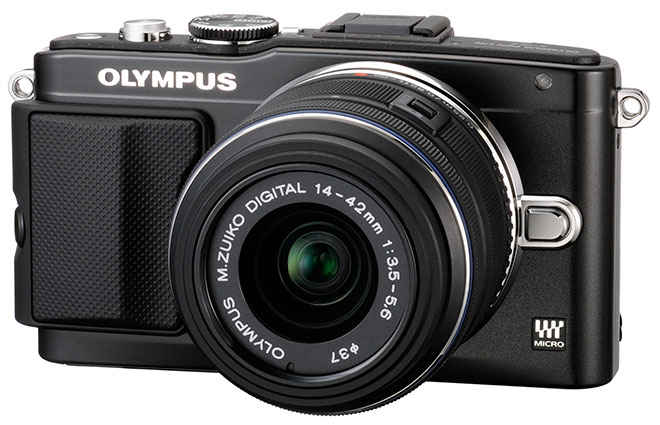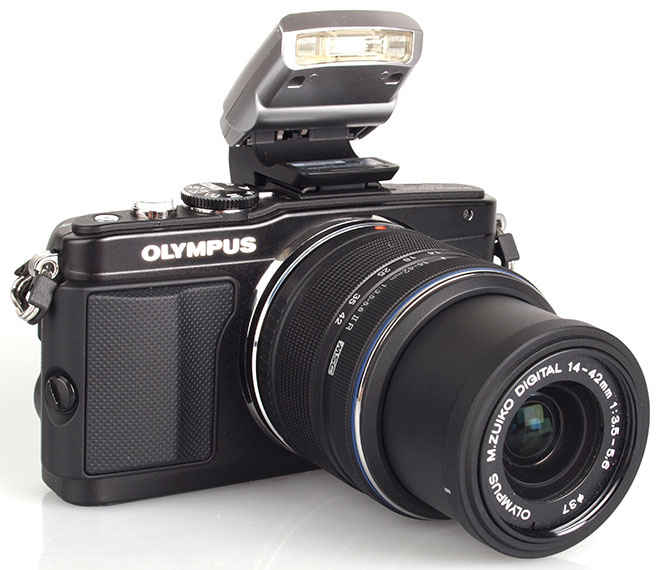The Olympus E-Pl5 boasts of a large number of features in a very compact body. It has the same sensor and image processor as the more expensive OM-D E-M5 and dishes out some rather amazing images. It is easy to use for the most part, but feels a little cramped. Yet, if you're looking for a mirrorless camera, you should consider this as your companion. Wondering why? Read on.
Build and Ergonomics
When you pull the E-PL5 out of its box, the first thing you notice is just how thin the camera is. Then you will also notice that the E-PL5 is not light by any means, the heft only lending to the surety of its sturdy build. Most of the heft, as it turns out, comes from the 3 inch screen on the back which has a resolution of 460K dots. The screen can only tilt up or down and doesn’t flip out, which is slightly disappointing. What it does do, however, is flip up 90 degrees so that you can take well composed “selfies.”
The bulkiest part of the camera happens to be the hand grip, which as it turns out, can be unscrewed from the body to make it more compact. However, we recommend against doing so, as the grip makes the camera incredibly comfortable to hold for long hours, something one could not get if the grip is removed.
Overall, the buttons on the camera feel a little cramped due to how little space there is left on the back once the 3 inch screen is accommodated. Not just that, but the buttons themselves are rather tiny, making the act of reaching for them somewhat difficult, especially if you have big thumbs. Olympus must have faced a tough decision, having to choose between putting lesser, but bigger, more functional buttons vs. small buttons, but more of them so that more functions are available instantaneously.
The other functional error Olympus made was with respect to the jog dial on the back. When shooting in aperture or shutter priority mode, the dial on the back does not change aperture (or shutterspeed) by default. You first need to press the dial in the up direction and then push it either left or right to change the values. If you’re in manual mode, then it’s the combination of left-right and up-down that changes values. Mostly all cameras nowadays map the changing of aperture/shutterspeed values to the dial by default, so having to push a button before these settings can be changed is rather counter intuitive. It takes some getting used to (not a lot though), but if you’ve been used to the other method of changing settings, then you are bound to be annoyed by Olympus’ settings, at least initially.
Lastly, the E-PL5 does not come with a pop-up flash, quite possibly another move to achieve the conservative dimensions of the camera. Instead, Olympus bundles a little flash unit into the box that can be plugged into the hot-shoe of the camera. Surprisingly, the flash is so compact that it does not actually get in the way of carrying this camera around. So if you’re worried that the camera would add bulk or become not-so-carry-friendly with the flash unit attached, be assured that that will not be the case.
Features:
There are a number of amazing features that have been packed into the E-PL5. For starters, the 16 megapixel sensor in this camera is the same one found in the OM-D E-M5, Olympus’s flagship mirrorless body which we know to be an excellent performer. It is accompanied by the TruPic VI image processor chip, which is also found in the bigger sibling.
Besides being a really solid performer in terms of image quality, the sensor in the E-PL5 also brings sensor-shift based image stabilization to the game, making every lens attached to the camera a stabilized lens.
The screen on the back may sport only 460K dots of resolution, but it is a full touch enabled screen, that allows both touch to focus and touch to shoot. While using the camera, we would simply tap on the screen where we wanted the focus to be and the camera would take a photo, bringing that area into focus in under a second. It’s incredible how fast the AF system is and how well it is integrated with the touch capabilities of the screen. The AF also offers face and eye detection, in case you’re all about shooting people.
For all those who love their extra features, the E-PL5 also offers on-board Wi-Fi which will allow you to shoot, view and share you photos on your camera directly through your iOS and Android device.
The Olympus E-PL5 is a tiny little camera that packs a crazy amount of features. For something this small, the E-PL5 is an incredibly feature packed camera. However, it still remains to be seen how it holds up under our tests.
Performance
The E-PL5 has a sensor and image processing chip that we know is an excellent performer. However, companies have a tendency to lower the performance throughput of sensors and chips when they’re taken out of high end devices and put into lower end devices. The AF system in the 5D Mark III is a good example of that, being the same from the 1Dx, but still not as competent.
The E-PL5, however, tends to steer clear of that degrading trend. Olympus has not stripped the sensor and the TruPic VI chip of any of their performance chops and we saw that as we shot with the E-PL5 rather extensively. We used the M.Zuiko Digital 14-42mm f3.5-5.6 II R Lens and the M.Zuiko 17mm f/1.8 prime lens for our testing and both lenses complimented the camera very well. The AF with both the lenses was incredibly fast, with the camera locking focus and firing off the shot all in under a second. When the light levels got low, the camera didn’t slow down and it was only when we shot very low contrast, dimly lit subjects that we started seeing the AF slow down noticeably (but still do its job).
In day time, using the camera was as simple as tapping on the screen and waiting less than a second for the photo to get written to the card and before we knew it, the camera was ready to shoot again. It’s no surprise that the E-PL5 can pull off 8 frames per second of burst mode.
When it came to shooting in low light, we bumped up the ISO to ISO 1600 and then 3200 without too much of a worry. Even when shooting in very low light conditions (E-PL5 paired with the 17mm f/1.8), the AF was incredibly spot on. We just wish the lenses had a better minimum focusing distance, but that’s not as much a quality issue as it is us being too demanding. Not once did we feel handicapped without our DSLR while using the E-PL5, which says quite a lot.
Looking at the images from our testing, some things are very apparent. Despite the small sensor, the Olympus E-PL5 is clearly delivering images in the APS-C league. The Dynamic range is nearly as good as we’ve seen coming out of the Sony NEX-6, and that in of itself is mighty impressive. The saturation was somewhat low for our liking, but we managed to tweak that in the picture profile settings. The same also goes for contrast, but the reason the contrast and saturation were somewhat low can be attributed to the fact that we were shooting in RAW. We prefer to tweak our image files straight in Lightroom, but if you prefer solid images straight out of the camera, you might have to tinker with the picture styles a bit. While we could go on and on about the image quality of the images from the E-PL5, we’d rather just let you take a look at them. These are all files straight out of the camera that have been converted from RAW to JPG using Lightroom.



.jpg)
Good Light Samples of the E-PL5's imaging capabilities. All images are straight out of camera.


Untouched, straight out of camera samples of low light performance
Shooting video on the E-PL5 is downright amazing, thanks to not just the 16:9 screen that allows proper framing, but also the fact that this is the first time a camera will allow you to touch-focus during filming. The E-PL5's Live control menu also allows you to change a range of settings independently of the same settings in stills shooting modes. These include the quality settings, exposure and AF modes, Picture Mode, ISO sensitivity, and audio recording. You can also set the movie stabilization, with the ability to choose from three options- Off, M-IS1, which provides additional stabilization to counteract walking motion, and M-IS2, the same 2-axis stabilization as the S-IS 1 stills.
One Major Gripe
While shooting with the E-PL5 is an amazing experience overall, the one feature of this camera that makes it a real pain to use is the somewhat convoluted menu system. The organization of the menu seems a little haphazard, with various settings being buried under various other options which don’t really follow a very logical path. While most of the buttons on the E-PL5 can be mapped to a variety of features, in order to be able to do so, you will have to jump through some major menu hoops to get to the relevant parts.
While the menu system isn’t perfect, it is something that one can get used to. We often don’t get to spend time with the review cameras on a long term basis, which means it’s hard to habituate to a new system. However, we’re sure that with enough time and use, anyone could get the hang of the menu, we just wish that the learning curve wasn’t so steep.
Conclusion
If an apt summary of the E-PL5 was to be written, we’d say it was nothing short of a mini OM-D E-M5. The camera has an incredibly fast AF which mostly shows little to no regard for whether the light is good or bad. It handles shooting conditions of up to ISO 3200 incredibly well and even ISO 6400 can be passable with a little bit of noise reduction. It has an incredibly fast burst rate of 8 frames per second, which is adequate enough to shoot most moving objects, or even a somewhat slow game of basketball.
Where it loses points for sure is the clunky menu system. Then there is the fact that straight out of camera photos can be a little flat, requiring users to tweak picture settings, but once you’ve done that, you’re hardly ever going to need to go back to this setting. Hopefully. Another area I'm not too happy about are the cramped buttons on the back, but that’s mostly because I have somewhat large fingers (and thumbs). While this shouldn't bother people with slender fingers, those who’ve been gifted with some extra skin would definitely find themselves hitting the wrong button every now and then.
Swapnil Mathur
Swapnil was Digit's resident camera nerd, (un)official product photographer and the Reviews Editor. Swapnil has moved-on to newer challenges. For any communication related to his stories, please mail us using the email id given here. View Full Profile








